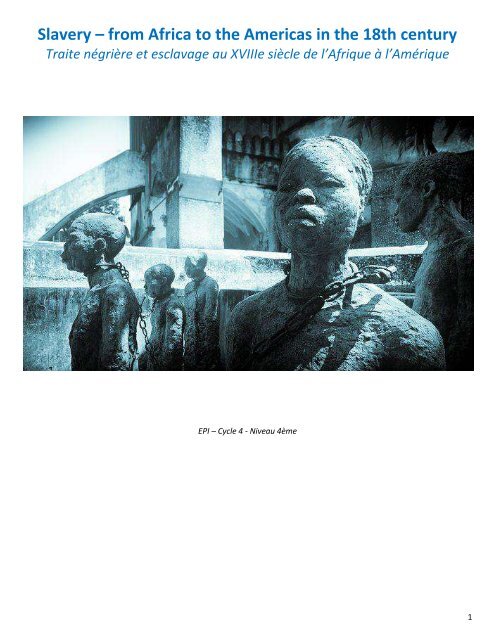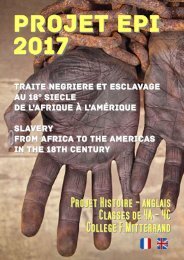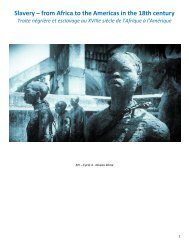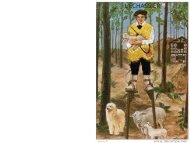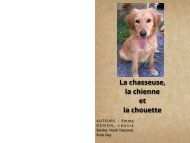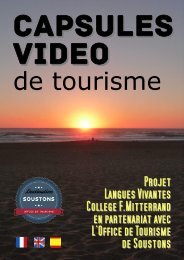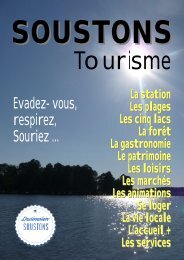EPI - Slavery – from Africa to the Americas 2017
Create successful ePaper yourself
Turn your PDF publications into a flip-book with our unique Google optimized e-Paper software.
<strong>Slavery</strong> <strong>–</strong> <strong>from</strong> <strong>Africa</strong> <strong>to</strong> <strong>the</strong> <strong>Americas</strong> in <strong>the</strong> 18th century<br />
Traite négrière et esclavage au XVIIIe siècle de l’Afrique à l’Amérique<br />
<strong>EPI</strong> <strong>–</strong> Cycle 4 - Niveau 4ème<br />
1
<strong>Slavery</strong> <strong>–</strong> <strong>from</strong> <strong>Africa</strong> <strong>to</strong> <strong>the</strong> <strong>Americas</strong> in <strong>the</strong> 18th century<br />
Traite négrière et esclavage au XVIIIe siècle de l’Afrique à l’Amérique<br />
Projet <strong>EPI</strong> : A partir de l’analyse de documents his<strong>to</strong>riques en Français ou en Anglais, raconter la vie d’un esclave depuis sa<br />
capture en Afrique jusqu’à sa vie en Amérique.<br />
Démarche en LV :<br />
Rebrassage, transfert et consolidation des acquis his<strong>to</strong>riques et géographiques (connaissances et compétences)<br />
Enrichissement culturel et linguistique en LV<br />
Perfectionnement de la lecture de documents his<strong>to</strong>riques en LV<br />
Pratique du récit au<strong>to</strong>biographique de fiction réaliste<br />
Sujets abordés en LV :<br />
Life and Capture in <strong>Africa</strong> <strong>–</strong> Slaves and Slaves Traders<br />
The Middle Passage <strong>–</strong> Slave ships<br />
Slave Auctions <strong>–</strong> Slaves, Slaves owners and Slave traders<br />
Life in America <strong>–</strong> Field slaves and House slaves<br />
Opposition <strong>to</strong> <strong>Slavery</strong> <strong>–</strong> Slave revolts <strong>–</strong> Slave fugitives<br />
Tâches intermédiaires (Préparation de la tâche finale):<br />
Slave Narratives <strong>–</strong> Analysis and Classification of information<br />
- Origins<br />
- Capture and journey <strong>to</strong> <strong>the</strong> <strong>Americas</strong><br />
- Family life<br />
- Work<br />
- Masters Slaves relationship<br />
- Culture and beliefs<br />
- Resistance and Rebellion<br />
- S<strong>to</strong>ry telling characteristics<br />
Slave Narratives <strong>–</strong> Choice of character<br />
A l’aide des documents étudiés et/ou présentés (documents iconographiques et textuels), choisir un personnage, définir<br />
son identité et sa personnalité.<br />
- Identity grid (name, age, sex, origins, mo<strong>the</strong>r <strong>to</strong>ngue, family background, date of capture, capturers, itinerary, personality …)<br />
Tâche finale:<br />
Slave Narratives <strong>–</strong> Production<br />
Sujet : A l’aide des documents étudiés et/ou présentés, de vos recherches thématiques, de vos observations… rédigez deux<br />
récits illustrés de la vie d’un esclave au XVIII° siècle. Vous veillerez à respecter les consignes.<br />
Consignes<br />
Ergonomie : A4 format « portrait » - Marges <strong>–</strong> Police <strong>–</strong> Taille de la police <strong>–</strong> Format numérique : pdf<br />
Style « Journal personnel <strong>–</strong> Journal intime » -<br />
Temps grammatical : narration au passé<br />
Un récit en français « de l'Afrique aux côtes américaines » + illustration. (1 page)<br />
Un récit en anglais « Slave life in America » + illustration (1 page)<br />
Utiliser le travail prépara<strong>to</strong>ire des tâches intermédiaires (choix du personnage, thématiques, caractéristiques du récit)<br />
Sélectionner un épisode représentatif de la vie d'un esclave au XVIIIe siècle pour chaque récit (Choisir et Développer un ou<br />
deux thèmes dans chaque récit)<br />
Vérifier la vraisemblance his<strong>to</strong>rique en notant les références des documents étudiés et/ou sélectionnés pour construire les<br />
récits (sources)<br />
2
1. BUILDING and REFRESHING BACKGROUNG KNOWLEDGE with Primary Sources<br />
Look at this document(1.1): What do you see? What do you think it means?<br />
What sort of document is it? (a drawing? a painting? a pho<strong>to</strong>? an engraving?...)<br />
Who are <strong>the</strong> masters? Who are <strong>the</strong> slaves?<br />
What are <strong>the</strong> slaves doing?<br />
What elements provide clues about <strong>the</strong> location and date?<br />
What does this document inform us of?<br />
Look for information about <strong>the</strong> importance of slavery in ancient Rome<br />
.<br />
3
Look at this document (1.2): What do you see? What do you think it means?<br />
What sort of document is it? (a drawing? a painting? a pho<strong>to</strong>? an engraving?...)<br />
Who are <strong>the</strong> masters? Who are <strong>the</strong> slaves?<br />
What provides clues about <strong>the</strong> location and <strong>the</strong> time period?<br />
What does this picture inform us of?<br />
Watch <strong>the</strong> video for more information: The Atlantic slave trade_ What <strong>to</strong>o few textbooks <strong>to</strong>ld you - Anthony Hazard.mp4<br />
Look for information about Arab Slave-trading.<br />
4
Look at this document (1.3): What do you see? What do you think it means?<br />
What sort of document is it? (a drawing? a painting? a pho<strong>to</strong>? an engraving?...)<br />
Who is <strong>the</strong> master? Who are <strong>the</strong> slaves?<br />
What are <strong>the</strong> slaves doing?<br />
What provides clues about <strong>the</strong> location and date?<br />
Watch <strong>the</strong> video for more information: The Atlantic slave trade_ What <strong>to</strong>o few textbooks <strong>to</strong>ld you - Anthony Hazard.mp4<br />
Look for information about Antera Duke.<br />
5
Look at this document (1.4): What do you see? What do you think it means?<br />
What sort of document is it? (a drawing? a painting? a pho<strong>to</strong>? an engraving?...)<br />
What provides clues about <strong>the</strong> location and date?<br />
What provides clues about <strong>the</strong> purpose of <strong>the</strong> building?<br />
Why are <strong>the</strong> cannons facing <strong>the</strong> ocean?<br />
Look for information about Cape Coast Castle.<br />
Which President visited Cape Coast Castle in 2009? Can you imagine why?<br />
6
2. Study maps<br />
Source: David Eltis and David Richardson, Atlas of <strong>the</strong> Transatlantic Slave Trade (New Haven, 2010)<br />
Look at <strong>the</strong> map (2.1)<br />
What can you learn <strong>from</strong> this map?<br />
Present your findings:<br />
Overview of <strong>the</strong> slave trade out of <strong>Africa</strong>, 1500-1900<br />
7
Look at <strong>the</strong> map (2.2)<br />
The Atlantic Slave Trade - Volume and Destinations 1701-1810<br />
Locate <strong>the</strong> continents, <strong>the</strong> oceans, <strong>the</strong> regions mentioned on <strong>the</strong> map (Brazil, British Caribbean ...)<br />
Why were <strong>the</strong> regions called “French” or “Dutch”?<br />
What Atlantic region had <strong>the</strong> most slaves?<br />
What Atlantic region had <strong>the</strong> least slaves?<br />
8
Look at <strong>the</strong> map (2.3)<br />
What can you learn <strong>from</strong> this map?<br />
Volume and direction of <strong>the</strong> trans-Atlantic slave trade <strong>from</strong> all <strong>Africa</strong>n <strong>to</strong> all American regions<br />
9
Trans-Atlantic <strong>Slavery</strong><br />
Describe this document (2.4)<br />
Trans-Atlantic Slave Trade<br />
Look at <strong>the</strong> title.<br />
What is <strong>the</strong> equivalent of “trans”? in in <strong>the</strong> middle across behind<br />
What is <strong>the</strong> equivalent of “trade”? travel commerce wind shopping<br />
10
Learn <strong>the</strong> geometrical shapes. Match each shape <strong>to</strong> <strong>the</strong> appropriate word.<br />
Triangle Rectangle Square Circle Pentagon Hexagon<br />
Read <strong>the</strong> following definitions and guess what shape <strong>the</strong>y correspond <strong>to</strong>.<br />
a) It is a three-sided polygon and it has got three legs:<br />
b) It is a six-sided polygon. It is <strong>the</strong> name given <strong>to</strong> France:<br />
c) It is an ellipse in which <strong>the</strong> two axes are of equal length:<br />
d) It is a five-sided polygon and it is also a government building with five sides that serves as <strong>the</strong> headquarters of <strong>the</strong> United<br />
States Department of Defense:<br />
What geometrical shape could you draw on <strong>the</strong> map?<br />
Could you draw a second similar shape on <strong>the</strong> map? Explain.<br />
What new information can we learn about slavery <strong>from</strong> <strong>the</strong> map (2.4)?<br />
11
3. LISTENING <strong>–</strong> Warm-up<br />
Read <strong>the</strong> following definitions and locate <strong>the</strong> countries of South America on <strong>the</strong> map<br />
Bolivia: The westernmost of <strong>the</strong> two landlocked countries in South America.<br />
Brazil: The biggest country in South America.<br />
Chile: A long, thin country in southwestern South America.<br />
Colombia: A country in <strong>the</strong> far northwest of South America.<br />
Ecuador: A country in northwestern South America; <strong>the</strong> equa<strong>to</strong>r passes through nor<strong>the</strong>rn Ecuador. Ecuador borders <strong>the</strong><br />
Pacific Ocean, is south of Colombia, and north of Peru.<br />
French Guiana: An overseas ‘départment’ of France that is located in nor<strong>the</strong>rn South America. It borders <strong>the</strong> Atlantic Ocean,<br />
Brazil, and Suriname.<br />
Paraguay: The easternmost of <strong>the</strong> two landlocked countries in South America.<br />
Peru: It borders <strong>the</strong> Pacific Ocean.<br />
Suriname: A small country in nor<strong>the</strong>rn South America. It borders <strong>the</strong> Atlantic Ocean, Brazil, Guyana, and French Guiana.<br />
Uruguay: A small country in sou<strong>the</strong>astern South America that is bordered by Brazil, Argentina and <strong>the</strong> Atlantic Ocean.<br />
Locate <strong>the</strong> countries on <strong>the</strong> map below.<br />
Cuba The Dominican Republic Puer<strong>to</strong> Rico Jamaica The Barbados Trinidad and Tobago The Bahamas<br />
12
You are going <strong>to</strong> listen <strong>to</strong> a conversation between two people.<br />
Listen <strong>to</strong> <strong>the</strong> recording “S9S3E11.mp3” once (= one time) or twice (= two times) if necessary.<br />
Who are <strong>the</strong>se people?<br />
The people are:<br />
a politician and a journalist<br />
a teacher and a writer<br />
<strong>the</strong> cura<strong>to</strong>r of a museum and a journalist<br />
Listen <strong>to</strong> <strong>the</strong> whole dialogue “S9S3E12.mp3” and focus only on names of continents, countries, seas, oceans and cities.<br />
Write <strong>the</strong>m down as soon as you have identified <strong>the</strong>m.<br />
1- Continents:<br />
2- Seas, oceans:<br />
3- Countries:<br />
4- Cities:<br />
Once you have identified <strong>the</strong> places, write <strong>the</strong>m at <strong>the</strong> correct places on <strong>the</strong> maps below. Use arrows!<br />
13
Now listen <strong>to</strong> <strong>the</strong> recording once again and write down all <strong>the</strong> words related <strong>to</strong> <strong>the</strong> following <strong>to</strong>pics:<br />
Commerce:<br />
Dates (years - centuries):<br />
Figures (numbers):<br />
What geometrical shape is mentioned several times in <strong>the</strong> recording?<br />
Listen <strong>to</strong> <strong>the</strong> recording “S9S3E14.mp3”<br />
Can you label <strong>the</strong> places at <strong>the</strong> three corners? Listen <strong>to</strong> <strong>the</strong> following extract <strong>from</strong> <strong>the</strong> dialogue.<br />
In <strong>the</strong> recording, you came across <strong>the</strong> following words (left column):<br />
Match each English word with its translation.<br />
guns • • perles<br />
swords • • armes à feu<br />
beads • • épées<br />
Metalware, iron products • • rhum<br />
rum • • alcool<br />
alcohol • • objets en metal<br />
Listen <strong>to</strong> <strong>the</strong> recording “S9S5E19.mp3” <strong>from</strong> <strong>the</strong> recording and tick <strong>the</strong> objects whose names you hear<br />
14
Listen <strong>to</strong> <strong>the</strong> recording “S9S5E20.mp3” and fill in <strong>the</strong> boxes.<br />
What did <strong>the</strong> following people expect <strong>from</strong> <strong>the</strong> Triangle Trade?<br />
Now recap what you unders<strong>to</strong>od and say who bought what and who sold what.<br />
1- …………………………………….. bought ................................................................................<br />
and sold ................................................................................................................<br />
2- ……………………………………... bought ................................................................................<br />
and sold .................................................................................................................<br />
3- …………………..…………………. bought ...............................................................................<br />
and sold .................................................................................................................<br />
Listen <strong>to</strong> <strong>the</strong> first part (#1) of <strong>the</strong> recording “S9S5E23.mp3” and answer <strong>the</strong> question:<br />
Why did some <strong>Africa</strong>n people become slaves and why were <strong>the</strong>y sold by <strong>the</strong>ir chiefs <strong>to</strong> American and European traders?<br />
Tick one box.<br />
Some people were born slaves.<br />
Under <strong>Africa</strong>n law, people who committed crimes were sentenced <strong>to</strong> slavery.<br />
They were not really slaves. They agreed <strong>to</strong> be sold as slaves.<br />
Listen <strong>to</strong> <strong>the</strong> second part (#2) of <strong>the</strong> recording:<br />
Try and pick out one word that justifies your answer (<strong>the</strong> most important word).<br />
Write it down:<br />
Now listen <strong>to</strong> extract #3 and complete <strong>the</strong> sentence below.<br />
Liverpool had a lot of .................................. , ………………………………..and <strong>the</strong>y all benefited <strong>from</strong> <strong>the</strong> ……………………………… .<br />
So Liverpool <strong>from</strong> that point of view became a major ……………………………………………… .<br />
15
GRAMMAR <strong>–</strong><br />
Observez attentivement les phrases :<br />
A) Slaves were people who were sold by <strong>Africa</strong>n kings in exchange for guns.<br />
B) Liverpool was a slave port where ships were built.<br />
Quelle est la nature des mots en gras ?<br />
Nommez l'antécédent (mots ou groupe de mots auxquels se rapportent les mots en gras) pour chaque phrase :<br />
Antécédent de who:<br />
Antécédent de where:<br />
Observez les formes verbales soulignées.<br />
C) <strong>Africa</strong>n kings sold slaves in exchange for guns.<br />
D) Slaves were sold by <strong>Africa</strong>n kings in exchange for guns.<br />
Quelle différence faites-vous entre les 2 phrases ?<br />
Dans la phrase C), ....................................................................... sont mis en valeur.<br />
Dans la phrase D), ....................................................................... sont mis en valeur.<br />
Dans le contexte du dialogue sur le commerce triangulaire, trouvez-vous logique que la phrase D) ait été prononcée plutôt<br />
que la phrase C) ? oui non<br />
Si oui, pour quelle raison selon vous ?<br />
Dans la phrase D, qui accomplit l’action (verbe = sell) ?<br />
Quel préposition introduit celui ou ceux qui accomplissent l’action ?<br />
Comment appelle-t-on ce groupe de mots (préposition + celui ou ceux qui accomplissent l’action) ?<br />
Reconnaissez-vous cette forme : ‘were sold’ ? oui, il s’agit d’un(e) ..................................<br />
A quel temps ?<br />
Dans la phrase B: Liverpool was a slave port where ships were built. Y a-t-il une forme passive ? oui<br />
non<br />
Si oui inscrivez-la ici : ...................................................................................................<br />
Traduisez en français les deux phrases<br />
A)<br />
B)<br />
16
Read <strong>the</strong> following text:<br />
80 % of all slaves shipped <strong>to</strong> <strong>the</strong> <strong>Americas</strong> were put <strong>to</strong> work on plantations. They worked long hours in<br />
<strong>the</strong> fields and were punished if <strong>the</strong>y did not work hard enough.<br />
O<strong>the</strong>r slaves worked in <strong>the</strong> house as servants, or were used <strong>to</strong> do o<strong>the</strong>r jobs around <strong>the</strong> plantation.<br />
Most slaves worked on plantations in <strong>the</strong> sou<strong>the</strong>rn states.<br />
Slaves were used on plantations for a variety of tasks: picking cot<strong>to</strong>n, harvesting <strong>to</strong>bacco, working in<br />
<strong>the</strong> dairy, washing clo<strong>the</strong>s, planting and harvesting rice, building railroads, carpentry, harvesting<br />
sugar cane, cooking, weaving, growing and harvesting coffee.<br />
Tool box: pick: cueillir, harvest: récolter, <strong>the</strong> dairy: la laiterie, rice: riz, railroads: voies ferrées, weave: tisser<br />
Find <strong>the</strong> English equivalent in <strong>the</strong> text of <strong>the</strong> following expressions:<br />
a) Ils étaient utilisés :<br />
b) Ils travaillaient de longues heures :<br />
c) Ils étaient punis :<br />
d) Ils travaillaient comme domestiques :<br />
e) On les mettait au travail dans les plantations :<br />
Focus on <strong>the</strong> following sentence: Slaves were put <strong>to</strong> work on plantations.<br />
a) What is <strong>the</strong> name of <strong>the</strong> verbal form that is used in this sentence (were put):<br />
.....................................................................................................................................................................................<br />
b) Look for its French translation in <strong>the</strong> above ACTIVITY and write it down:<br />
.....................................................................................................................................................................................<br />
c) What personal pronoun is used in French?<br />
.....................................................................................................................................................................................<br />
d) Look at <strong>the</strong> following sentences and answer <strong>the</strong> questions:<br />
- They were put <strong>to</strong> work on plantations.<br />
- Slaves were punished if <strong>the</strong>y did not work enough.<br />
- They were used as servants.<br />
- Slaves were used on plantations.<br />
Who ‘put <strong>the</strong> slaves <strong>to</strong> work’?<br />
Are <strong>the</strong>y mentioned in <strong>the</strong> above sentences? yes<br />
no<br />
Why? Why not?<br />
17
GRAMMAIRE <strong>–</strong> Récapitulons et Approfondissons<br />
Vous avez reconnu la voix passive dans les phrases précédentes.<br />
Vous savez que lorsque l’on emploie le passif l’expression de l’agent de l’action peut ne pas être ressentie comme<br />
nécessaire, car son identité est évidente ou représente peu d’intérêt.<br />
Dans la phrase : Slaves were put <strong>to</strong> work, l’agent n’est pas mentionné car il est évident.<br />
Ce sont les …………………………………… qui mettaient au travail les esclaves.<br />
On sait parfaitement qui employait les esclaves dans les plantations.<br />
Recopiez à nouveau la traduction en français de la phrase : slaves were put <strong>to</strong> work on plantations.<br />
Remarquez le recours au pronom personnel « on ». En français, on utilise « on » car on ne définit pas de qui il s’agit.<br />
- Slaves were put <strong>to</strong> work on mettait les esclaves au travail.<br />
- Slaves were used as servants (traduisez)<br />
- They were used on plantations (traduisez)<br />
- They were punished if <strong>the</strong>y did not work hard enough (traduisez)<br />
Lorsque le complément d’agent est nécessaire, on l’introduit par by :<br />
Olaudah was very well treated by <strong>the</strong> sea Captain, who allowed <strong>the</strong> sailors on board <strong>the</strong> ship <strong>to</strong> teach him <strong>to</strong> read and <strong>to</strong><br />
write. (Olaudah était très bien traité par le capitaine du bateau, qui au<strong>to</strong>risait les marins à lui apprendre à lire et à écrire.)<br />
Translate in<strong>to</strong> English <strong>the</strong> following sentences.<br />
1- On vendit Olaudah à un autre marchand d’esclaves.<br />
2- On n’attacha (chain) pas Olaudah comme les hommes et femmes parce qu’il était jeune (en raison de sa jeunesse).<br />
3- On l’au<strong>to</strong>risa à s’asseoir sur le pont (deck) le jour, mais pas la nuit.<br />
4- On emmena Olaudah dans une grande plantation.<br />
5- On fouettait (whip) les esclaves qui ne voulaient pas obéir.<br />
18
Entrainez-vous <strong>–</strong> Transformez les phrases suivantes à la voie passive (faites attention au temps):<br />
1) In <strong>the</strong> fields in <strong>the</strong> South, slaves picked up cot<strong>to</strong>n.<br />
2) Masters <strong>from</strong> <strong>the</strong> South didn’t pay <strong>the</strong>ir slaves.<br />
3) The master often forces <strong>the</strong> slaves <strong>to</strong> wear an iron collar.<br />
4) Someone whipped <strong>the</strong> slaves if <strong>the</strong>y rebelled. (Sera-t-il nécessaire de mentionner le complément d’agent?, pourquoi ?)<br />
Active or Passive Voice?<br />
When we (arrive) on <strong>the</strong> American land, most of us (suffer) <strong>from</strong> starvation and thirst.<br />
We (ill-treat) and many of my friends (injure) . We (separate)<br />
and we (send)<br />
<strong>to</strong> different plantations in different regions of America.<br />
I (arrive) on <strong>the</strong> plantation late one evening. My master and his family (own) a<br />
cot<strong>to</strong>n plantation. They (treat) us like animals! Every day, we (get up) at dawn and we<br />
(work) until sunset. We (not allow) <strong>to</strong> talk while working. We (forbid)<br />
<strong>to</strong> take more than two breaks a day. Some of my friends (try)<br />
<strong>to</strong> run away but <strong>the</strong>y<br />
(catch) . Some of <strong>the</strong>m (<strong>to</strong>rture) and some even (disappear) .<br />
Maybe <strong>the</strong>y (kill) .<br />
Rédigez 3 phrases à la voie passive au sujet de la vie d’un esclave en Amérique.<br />
a)<br />
b)<br />
c)<br />
19
Play <strong>the</strong> recording “S9S3E12.mp3”again and read <strong>the</strong> transcript of <strong>the</strong> dialogue you have been working on at <strong>the</strong> same<br />
time<br />
M.H.: In 1994, National Museums Liverpool opened <strong>the</strong> Transatlantic <strong>Slavery</strong> Gallery, <strong>the</strong> first of its kind in<br />
<strong>the</strong> world. Our aim was <strong>to</strong> look at <strong>the</strong> deep impact of slavery and <strong>the</strong> slave trade on <strong>Africa</strong>, South America<br />
and <strong>the</strong> Caribbean (Suriname, Puer<strong>to</strong> Rico, Cuba, Ecuador, Peru, Colombia, Brazil and Jamaica), <strong>the</strong> USA and<br />
Western Europe.<br />
Paul Deen: So what can you tell us about <strong>the</strong> museum’s exhibition?<br />
M.H.: The <strong>Slavery</strong> Museum has three main galleries on <strong>the</strong> following <strong>the</strong>mes: Life in West <strong>Africa</strong> -<br />
Enslavement and <strong>the</strong> Middle Passage and Legacies of slavery<br />
Paul Deen: Can you explain <strong>the</strong> term ‘triangle trade’ or ‘triangular trade’ for us? How did it all start?<br />
M.H.: Well, <strong>from</strong> trading with <strong>the</strong> <strong>Africa</strong>ns, Europeans knew that slavery was used as a punishment for<br />
serious crimes in <strong>Africa</strong>. They began <strong>to</strong> ask for slaves, ra<strong>the</strong>r than <strong>Africa</strong>n goods, in exchange for <strong>the</strong> guns<br />
and alcohol that <strong>the</strong> <strong>Africa</strong>n chiefs wanted. Guns, swords, beads, metalware, iron products, rum, yes, those<br />
sorts of things. The <strong>Africa</strong>n chiefs agreed and so <strong>the</strong> Triangular Trade was developed.<br />
Paul Deen: What part did Britain play in <strong>the</strong> triangle trade?<br />
M.H.: Britain was a major player in <strong>the</strong> transatlantic slave trade. Yes, Britain realized <strong>the</strong>re was a market<br />
out <strong>the</strong>re in <strong>Africa</strong>. British ships carried 2,600,000 enslaved <strong>Africa</strong>ns in <strong>the</strong> 18th century <strong>to</strong> <strong>the</strong> Caribbean<br />
and <strong>the</strong> <strong>Americas</strong>. London was <strong>the</strong> leading British slaving port in <strong>the</strong> 17th century. Then Bris<strong>to</strong>l over<strong>to</strong>ok<br />
London in <strong>the</strong> 1730s, and Liverpool over<strong>to</strong>ok Bris<strong>to</strong>l in <strong>the</strong> 1740s. So, Liverpool <strong>from</strong> that point of view<br />
became a major slaving port.<br />
Paul Deen: What else is <strong>the</strong>re <strong>to</strong> know about <strong>the</strong> triangle trade?<br />
M.H.: Liverpool had a lot of shipbuilders, ship-owners and <strong>the</strong>y all benefited <strong>from</strong> <strong>the</strong> slave trade. So goods<br />
left Liverpool, all <strong>the</strong> things <strong>the</strong>y needed <strong>to</strong> trade with <strong>Africa</strong>n kings left Liverpool. And when it got <strong>to</strong> <strong>Africa</strong>,<br />
it offloaded those goods for trading and <strong>to</strong>ok on <strong>the</strong> slaves, and <strong>the</strong>n made <strong>the</strong>ir journey <strong>to</strong> <strong>the</strong> Caribbean.<br />
Which <strong>the</strong>n offloaded <strong>the</strong> slaves, and <strong>to</strong>ok on all <strong>the</strong> sugar, tea, coffee, <strong>to</strong>bacco, cot<strong>to</strong>n, rum, and <strong>the</strong>n<br />
brought it back <strong>to</strong> places like Bris<strong>to</strong>l and Liverpool and London. The ships followed a route <strong>from</strong> England <strong>to</strong><br />
<strong>Africa</strong>, <strong>from</strong> <strong>Africa</strong> <strong>to</strong> <strong>the</strong> <strong>Americas</strong> and back <strong>to</strong> Europe. The route formed a triangle with three legs.<br />
Paul Deen: What can you tell us about <strong>the</strong> European traders? Who were <strong>the</strong>y?<br />
M.H.: Well…. The main European nations involved in slaving were Portugal, Spain, Britain, France, <strong>the</strong><br />
Ne<strong>the</strong>rlands, Denmark and Sweden. The main British ports that were involved in <strong>the</strong> slave trade were as I<br />
said Liverpool, London, Bris<strong>to</strong>l<br />
and <strong>the</strong> o<strong>the</strong>r European ports were Amsterdam, Barcelona, Bordeaux, Cadiz, Lisbon and Nantes.<br />
20
Then, concentrate on <strong>the</strong> paragraphs in Italic. Underline <strong>the</strong> verbs corresponding <strong>to</strong> <strong>the</strong> goods bought/sold by <strong>the</strong><br />
triangle traders.<br />
Write <strong>the</strong>m down in <strong>the</strong> relevant arrows ().<br />
Goods that were needed <strong>to</strong> trade with <strong>Africa</strong>n kings ........................................ Liverpool.<br />
The British ships ......................................... those goods for trading when <strong>the</strong>y got <strong>to</strong> <strong>Africa</strong> and ......................... <strong>the</strong><br />
slaves.<br />
Then <strong>the</strong> ships made <strong>the</strong>ir journey <strong>to</strong> <strong>the</strong> Caribbean.<br />
They ......................... <strong>the</strong> slaves <strong>the</strong>re and ......................... all <strong>the</strong> sugar, tea, coffee, <strong>to</strong>bacco, cot<strong>to</strong>n, rum.<br />
British ships ......................... 2,600,000 enslaved <strong>Africa</strong>ns in <strong>the</strong> 18th century <strong>to</strong> <strong>the</strong> Caribbean and <strong>the</strong> <strong>Americas</strong>.<br />
The ships ......................... those goods ………….. <strong>to</strong> Liverpool, Bris<strong>to</strong>l or London.<br />
Write down <strong>the</strong> verbs you have identified in <strong>the</strong> previous ACTIVITY.<br />
Then match <strong>the</strong>m <strong>to</strong> <strong>the</strong> appropriate translation.<br />
1- ....................................................................................................................................<br />
2- ....................................................................................................................................<br />
3- ....................................................................................................................................<br />
4- ....................................................................................................................................<br />
5- ....................................................................................................................................<br />
Now recap what <strong>the</strong> slave trade was.<br />
décharger transporter quitter prendre (embarquer) rapporter<br />
Complete <strong>the</strong> following text with <strong>the</strong> appropriate prepositions: <strong>from</strong> <strong>to</strong> across <strong>to</strong> back on<br />
The ships left Bris<strong>to</strong>l and sailed …………… <strong>Africa</strong>. The British bought slaves …………… <strong>the</strong> king, <strong>the</strong>n sailed …………… <strong>the</strong><br />
Caribbean. There <strong>the</strong>y offloaded <strong>the</strong> slaves, <strong>to</strong>ok …………… sugar, tea, coffee, <strong>to</strong>bacco, cot<strong>to</strong>n and rum and went ……………<br />
Liverpool or Bris<strong>to</strong>l.<br />
Complete with <strong>the</strong> appropriate passive forms :<br />
Slaves …………………….. for beads and guns, <strong>the</strong>n ………………….. across <strong>the</strong> Atlantic <strong>to</strong> <strong>the</strong> plantations and …………………….. by<br />
<strong>the</strong> planters. Sugar and cot<strong>to</strong>n ………………………………………………..…………….. <strong>to</strong> Liverpool or Bris<strong>to</strong>l.<br />
Help: BRING BACK - TAKE <strong>–</strong> BUY <strong>–</strong> SELL<br />
21
Recap what you know about The Atlantic slave trade: Tick <strong>the</strong> right boxes (Several boxes can be ticked)<br />
1- Also known as:<br />
<strong>the</strong> Triangle Trade <strong>the</strong> Triangular Trade <strong>the</strong> <strong>Africa</strong>n Trade,<br />
<strong>the</strong> Atlantic slave trade was <strong>the</strong> trading of mostly:<br />
<strong>Africa</strong>n people Spanish people European people,<br />
<strong>to</strong> <strong>the</strong> colonies of: <strong>the</strong> New World <strong>the</strong> <strong>Americas</strong> South America<br />
that occurred in and around <strong>the</strong> Atlantic Ocean.<br />
2- It lasted <strong>from</strong> <strong>the</strong>: 16th 15th 18th century<br />
<strong>to</strong> <strong>the</strong>: 17th 18th 19th century<br />
3- Most enslaved people were shipped <strong>from</strong>: Europe North <strong>Africa</strong> West <strong>Africa</strong> Central <strong>Africa</strong><br />
and taken <strong>to</strong>: <strong>Africa</strong> North America South America<br />
<strong>to</strong> work as unpaid slaves on:<br />
sugar plantations coffee plantations pepper plantations tea plantations<br />
cocoa plantations cot<strong>to</strong>n plantations, in gold and silver mines in houses <strong>to</strong> work as servants.<br />
4- Most contemporary his<strong>to</strong>rians estimate that between:<br />
2 million 5 million 9 million and: 5 million 9 million 12 million <strong>Africa</strong>ns<br />
arrived in <strong>the</strong> New World.<br />
5- The slave-trade is sometimes called <strong>the</strong> Triangular Trade<br />
and its: Middle Passage Third Passage Slave Passage<br />
which ultimately involved:<br />
two three four continents,<br />
two three four centuries and millions of people.<br />
Match <strong>the</strong> words or expressions (in <strong>the</strong> above ACTIVITY) with <strong>the</strong> appropriate synonym or equivalent.<br />
also known as… • • finally, in <strong>the</strong> end<br />
mostly • • placed on board a ship<br />
it lasted • • mainly<br />
enslaved people • • it persisted<br />
shipped • • also called…<br />
ultimately • • held in slavery<br />
Now recap orally what you know about <strong>the</strong> Triangular Trade and slavery.<br />
You can read <strong>the</strong> whole sentences <strong>from</strong> <strong>the</strong> above ACTIVITY aloud or make your own sentences.<br />
22
XTRA ACTIVITY - The Slave Ship<br />
Read <strong>the</strong> definitions below. Then use <strong>the</strong> words in bold type <strong>to</strong> label <strong>the</strong> parts of <strong>the</strong> slave ship.<br />
The main-mast is <strong>the</strong> tallest mast of <strong>the</strong> ship. The main-mast holds <strong>the</strong> main-sail.<br />
The bowsprit is a pole that stretches out over <strong>the</strong> sea <strong>from</strong> <strong>the</strong> prow of <strong>the</strong> ship.<br />
The fore-mast is <strong>the</strong> second tallest mast of <strong>the</strong> ship. It stands between <strong>the</strong> main-mast and <strong>the</strong> bowsprit.<br />
The mizzen-mast is <strong>the</strong> third tallest mast of <strong>the</strong> ship, near <strong>the</strong> captain’s cabin.<br />
The deck is <strong>the</strong> open-air working area for seamen.<br />
Coppering protected <strong>the</strong> hull <strong>from</strong> destructive worms.<br />
The area under <strong>the</strong> deck is <strong>the</strong> hold, for s<strong>to</strong>ring cargo. It was also a prison area for <strong>Africa</strong>n captives.<br />
The captain’s cabin is <strong>the</strong> ship’s most comfortable living space. It often had large windows looking out <strong>to</strong> sea.<br />
The <strong>Africa</strong>n men’s quarters are in <strong>the</strong> hold, between <strong>the</strong> main-mast and <strong>the</strong> fore-mast.<br />
The <strong>Africa</strong>n women’s quarters are in <strong>the</strong> hold between <strong>the</strong> main-mast and <strong>the</strong> mizzen-mast.<br />
Hatches are entrances <strong>to</strong> lower areas, such as <strong>the</strong> hold and captain’s cabin.<br />
Cannons are big guns aimed at <strong>the</strong> sea, for fighting pirates, and ships <strong>from</strong> anti-slavery nations.<br />
The barricado is <strong>the</strong> thick wall between <strong>the</strong> captain’s cabin and deck. If <strong>the</strong>y fought <strong>from</strong> behind this wall, <strong>the</strong> crew might<br />
hold off a slave mutiny.<br />
Swivel guns are aimed through holes in <strong>the</strong> barricado.<br />
The cargo area is between <strong>the</strong> men’s prison and <strong>the</strong> women’s prison. It held trade goods as well as food for captive<br />
<strong>Africa</strong>ns.<br />
Netting is a woven mesh placed around <strong>the</strong> deck, above <strong>the</strong> rail, <strong>to</strong> keep <strong>the</strong> <strong>Africa</strong>ns <strong>from</strong> leaping in<strong>to</strong> <strong>the</strong> sea.<br />
In West <strong>Africa</strong>, <strong>the</strong> ship had <strong>to</strong> rest in deep waters, but <strong>the</strong> rowboat <strong>to</strong>ok men <strong>to</strong> shore and brought captives back.<br />
Sharks are flesh-eating fish that followed <strong>the</strong> ship across <strong>the</strong> Atlantic. They fed on <strong>the</strong> bodies thrown in<strong>to</strong> <strong>the</strong> sea.<br />
Then find <strong>the</strong> French equivalents for <strong>the</strong>se words and write <strong>the</strong>m in your copybook<br />
23
4. Primary Sources<br />
Study this document (4.1)<br />
Try <strong>to</strong> find <strong>the</strong> most important elements<br />
Answer <strong>the</strong> following questions<br />
What kind of document is this?<br />
an advertisement a poster a poem<br />
an obituary a book cover<br />
What is it for?<br />
a <strong>the</strong>atre play<br />
a conference<br />
a Slave Sale<br />
a circus<br />
Look at <strong>the</strong> two characters. What are <strong>the</strong>ir differences?<br />
Can you imagine why <strong>the</strong>y are different?<br />
What is <strong>the</strong> date of <strong>the</strong> sale?<br />
Where is <strong>the</strong> sale?<br />
Who are <strong>the</strong> sellers?<br />
What is <strong>the</strong> name of <strong>the</strong> ship transporting slaves?<br />
What’s <strong>the</strong> name of <strong>the</strong> captain?<br />
How many people are concerned with this sale?<br />
Where are <strong>the</strong> slaves <strong>from</strong>?<br />
What adjectives are used <strong>to</strong> describe <strong>the</strong> slaves?<br />
What kind of sale do you imagine it is? Do you imagine a fixed price or ano<strong>the</strong>r context?<br />
24
Study <strong>the</strong>se documents and identify how cruelty is represented (4.2)<br />
25
Study <strong>the</strong>se documents and identify how cruelty is represented (4.3)<br />
26
Study <strong>the</strong>se documents and identify how slave work is represented (4.4)<br />
27
Study <strong>the</strong>se documents and identify how slave work is represented (4.5)<br />
28
Study <strong>the</strong>se documents and identify how slave work is represented (4.6)<br />
29
What can you say about this document? (4.7)<br />
Help<br />
What kind of document is it?<br />
Can you identify <strong>the</strong> man with a black hat?<br />
What is atmosphere like?<br />
Is it representative of <strong>the</strong> lives of most slaves? Why?<br />
30
5. Slave Narratives <strong>–</strong> Analysis and Classification of information<br />
Read <strong>the</strong> following slave narrative(s) once and focus on what you understand<br />
Read <strong>the</strong> following slave narratives(s) again and identify <strong>the</strong> main <strong>to</strong>pic(s)<br />
Key words<br />
Topic(s)<br />
Read <strong>the</strong> following slave narrative(s) again <strong>–</strong> Collect and classify <strong>the</strong> information about <strong>the</strong> character(s)<br />
Name<br />
Age<br />
Sex<br />
Origins<br />
Identity of <strong>the</strong><br />
character(s)<br />
Mo<strong>the</strong>r <strong>to</strong>ngue<br />
Family background<br />
Date of capture<br />
itinerary<br />
Personality<br />
Character # 1 Character # 2 Character # 3 Character # 4<br />
Read <strong>the</strong> following slave narrative(s) again <strong>–</strong> Collect and catalog <strong>the</strong> information about <strong>the</strong> following <strong>the</strong>mes:<br />
Origins<br />
Capture and journey <strong>to</strong> <strong>the</strong> <strong>Americas</strong><br />
Family life<br />
Work<br />
Masters <strong>–</strong> Slaves relationship<br />
Culture and beliefs<br />
Resistance and Rebellion<br />
S<strong>to</strong>ry telling characteristics<br />
31
Read <strong>the</strong> following slave narratives (5.1):<br />
My New Master Was Only Two<br />
“My earliest recollection is <strong>the</strong> day my old boss presented me <strong>to</strong> his son, Joe, as his property. I was about five years old and<br />
my new master was only two … No, sir, I never went in<strong>to</strong> books. I used <strong>to</strong> handle a big dictionary three times a day, but it<br />
was only <strong>to</strong> put it on a chair so my young master could sit up higher at <strong>the</strong> table. I never went <strong>to</strong> school. I learned <strong>to</strong> talk<br />
pretty good by associating with my masters in <strong>the</strong>ir big house.”<br />
Martin Jackson, Texas<br />
Mush and Beans<br />
“I remember quite well how those poor little children used <strong>to</strong> have <strong>to</strong> eat. They were fed in boxes and troughs, under<br />
<strong>the</strong> house. They were fed cornmeal mush and beans. When this was poured in<strong>to</strong> <strong>the</strong>ir box, <strong>the</strong>y would ga<strong>the</strong>r around it <strong>the</strong><br />
same as we see pigs, horses and cattle ga<strong>the</strong>r around troughs <strong>to</strong>day.”<br />
Octavia George, Oklahoma<br />
Bells and Horns<br />
“Bells and horns! Bells for dis and horns for dat! All we knowed was go and come by de bells and horns! Old ram horn blow<br />
<strong>to</strong> send us all <strong>to</strong> de field. We all line up, about 75 field niggers, and go by de <strong>to</strong>olshed and git our hoes, or maybe go hitch up<br />
de mules <strong>to</strong> de plows.”<br />
Charley Williams, Arkansas<br />
300 Pounds of Cot<strong>to</strong>n<br />
“I used <strong>to</strong> have <strong>to</strong> pick cot<strong>to</strong>n and sometime I pick 300 pound and <strong>to</strong>te it a mile <strong>to</strong> de cot<strong>to</strong>n house. Some pick 300 <strong>to</strong> 800<br />
pound cot<strong>to</strong>n and have <strong>to</strong> <strong>to</strong>te de bag de whole mile <strong>to</strong> de gin. Iffen dey didn’t do dey work, dey git whip till dey have blister<br />
on ’em … I never git whip, cause I allus git my 300 pound.”<br />
Sarah Ashley, Texas<br />
Read <strong>the</strong> following slave narrative (5.2):<br />
Going Across <strong>the</strong> River<br />
“An old woman … <strong>to</strong>ld me she had a real pretty girl <strong>the</strong>re who wanted <strong>to</strong> go across <strong>the</strong> river <strong>to</strong> Ripley, Ohio, and would I take<br />
her? I was scared, and backed out in a hurry. But <strong>the</strong>n I saw <strong>the</strong> girl, and she was such a pretty little thing … I don’t know<br />
how I ever rowed <strong>the</strong> boat across <strong>the</strong> river; <strong>the</strong> current was strong and I was trembling. I couldn’t see a thing <strong>the</strong>re in <strong>the</strong><br />
dark, but I felt <strong>the</strong> girl’s eyes … Well, pretty soon I saw a tall light and when I got up <strong>to</strong> it, two men reached down and<br />
grabbed her. I started tremblin’ all over again and prayin’. Then, one of <strong>the</strong> men <strong>to</strong>ok my arm and I just felt down inside of<br />
me that <strong>the</strong> Lord had got ready for me. ‘You hungry, Boy?’ is what he asked me.<br />
“That was my first trip; it <strong>to</strong>ok me a long time <strong>to</strong> get over my scared feelin’, but I finally did, and I soon found myself goin’<br />
back across <strong>the</strong> river, with two and three people, and sometimes a whole boatload. I got so I used <strong>to</strong> make three and four<br />
trips a month …<br />
“I never saw my passengers. It would have <strong>to</strong> be <strong>the</strong> ‘black nights’ of <strong>the</strong> moon when I would carry <strong>the</strong>m … I guess you<br />
wonder what I did with <strong>the</strong>m after I got <strong>the</strong>m over <strong>the</strong> river. Well, <strong>the</strong>re in Ripley was a man named Mr. Rankins; I think <strong>the</strong><br />
rest of his name was John. He had a regular station <strong>the</strong>re on his place for escaping slaves. You see, Ohio was a free state and<br />
once <strong>the</strong>y got over <strong>the</strong> river <strong>from</strong> Kentucky or Virginia, Mr. Rankins could strut <strong>the</strong>m all around <strong>to</strong>wn, and nobody would<br />
bo<strong>the</strong>r ’em … Didn’t many of ’em stay around that part of Ohio, though, because <strong>the</strong>re was <strong>to</strong>o much danger that you would<br />
be walking along free one night, feel a hand over your mouth, and be back across <strong>the</strong> river and in slavery again in <strong>the</strong><br />
morning.<br />
“And nobody in <strong>the</strong> world ever got a chance <strong>to</strong> know as much misery as a slave that had escaped and been caught.”<br />
Arnold Grags<strong>to</strong>n, Florida<br />
32
Read <strong>the</strong> following slave narratives (5.3):<br />
The Interesting Narrative of <strong>the</strong> Life of Olaudah Equiano, Or Gustavus Vassa, The <strong>Africa</strong>n: Written By Himself<br />
Chapter II (In <strong>Africa</strong> and on board a slave ship)<br />
[…] One day, when all our people were gone out <strong>to</strong> <strong>the</strong>ir works as usual, and only I and my dear sister were left <strong>to</strong> mind <strong>the</strong><br />
house, two men and a woman got over our walls, and in a moment seized us both, and, without giving us time <strong>to</strong> cry out, or<br />
make resistance, <strong>the</strong>y s<strong>to</strong>pped our mouths, and ran off with us in<strong>to</strong> <strong>the</strong> nearest wood. Here <strong>the</strong>y tied our hands, and<br />
continued <strong>to</strong> carry us as far as <strong>the</strong>y could, till night came on, when we reached a small house, where <strong>the</strong> robbers halted for<br />
refreshment, and spent <strong>the</strong> night. We were <strong>the</strong>n unbound, but were unable <strong>to</strong> take any food; and, being quite overpowered<br />
by fatigue and grief, our only relief was some sleep, which allayed our misfortune for a short time.<br />
[…] The people I was sold <strong>to</strong> used <strong>to</strong> carry me very often, when I was tired, ei<strong>the</strong>r on <strong>the</strong>ir shoulders or on <strong>the</strong>ir backs. I saw<br />
many convenient well-built sheds along <strong>the</strong> roads, at proper distances, <strong>to</strong> accommodate <strong>the</strong> merchants and travellers, who<br />
lay in those buildings along with <strong>the</strong>ir wives, who often accompany <strong>the</strong>m; and <strong>the</strong>y always go well armed.<br />
[…] The first object which saluted my eyes when I arrived on <strong>the</strong> coast was <strong>the</strong> sea, and a slave ship, which was <strong>the</strong>n riding at<br />
anchor, and waiting for its cargo. These filled me with as<strong>to</strong>nishment, which was soon converted in<strong>to</strong> terror when I was<br />
carried on board. I was immediately handled and <strong>to</strong>ssed up <strong>to</strong> see if I were sound by some of <strong>the</strong> crew; and I was now<br />
persuaded that I had gotten in<strong>to</strong> a world of bad spirits, and that <strong>the</strong>y were going <strong>to</strong> kill me. Their complexions <strong>to</strong>o differing<br />
so much <strong>from</strong> ours, <strong>the</strong>ir long hair, and <strong>the</strong> language <strong>the</strong>y spoke, (which was very different <strong>from</strong> any I had ever heard) united<br />
<strong>to</strong> confirm me in this belief.<br />
[…] When I looked round <strong>the</strong> ship <strong>to</strong>o and saw a large furnace or copper boiling, and a multitude of black people of every<br />
description chained <strong>to</strong>ge<strong>the</strong>r, every one of <strong>the</strong>ir countenances expressing dejection and sorrow, I no longer doubted of my<br />
fate; and, quite overpowered with horror and anguish, I fell motionless on <strong>the</strong> deck and fainted.<br />
Read <strong>the</strong> following slave narratives (5.4):<br />
The Interesting Narrative of <strong>the</strong> Life of Olaudah Equiano, Or Gustavus Vassa, The <strong>Africa</strong>n: Written By Himself<br />
Chapter II (In America)<br />
[…] What struck me first was that <strong>the</strong> houses were built with s<strong>to</strong>ries, and in every o<strong>the</strong>r respect different <strong>from</strong> those in<br />
<strong>Africa</strong>: but I was still more as<strong>to</strong>nished on seeing people on horseback. I did not know what this could mean; and indeed I<br />
thought <strong>the</strong>se people were full of nothing but magical arts.<br />
[…] We were not many days in <strong>the</strong> merchant's cus<strong>to</strong>dy before we were sold after <strong>the</strong>ir usual manner, which is this:--On a<br />
signal given,(as <strong>the</strong> beat of a drum) <strong>the</strong> buyers rush at once in<strong>to</strong> <strong>the</strong> yard where <strong>the</strong> slaves are confined, and make choice of<br />
that parcel <strong>the</strong>y like best.<br />
[…] I remember […], <strong>the</strong>re were several bro<strong>the</strong>rs, who, in <strong>the</strong> sale, were sold in different lots; and it was very moving on this<br />
occasion <strong>to</strong> see and hear <strong>the</strong>ir cries at parting.<br />
[…] While I was in this plantation <strong>the</strong> gentleman, <strong>to</strong> whom I suppose <strong>the</strong> estate belonged, being unwell, I was one day sent<br />
for <strong>to</strong> his dwelling house <strong>to</strong> fan him; when I came in<strong>to</strong> <strong>the</strong> room where he was I was very much affrighted at some things I<br />
saw, and <strong>the</strong> more so as I had seen a black woman slave as I came through <strong>the</strong> house, who was cooking <strong>the</strong> dinner, and <strong>the</strong><br />
poor creature was cruelly loaded with various kinds of iron machines; she had one particularly on her head, which locked her<br />
mouth so fast that she could scarcely speak; and could not eat nor drink. I was much as<strong>to</strong>nished and shocked at this<br />
contrivance, which I afterwards learned was called <strong>the</strong> iron muzzle.<br />
33
Read <strong>the</strong> following slave narratives (5.5):<br />
I have said little about my mo<strong>the</strong>r. She was a slave and as such was housemaid. This brought her in close contact with <strong>the</strong><br />
white people and gave her training not common <strong>to</strong> <strong>the</strong> masses of colored women of her day. Her duties were such however,<br />
that she could give but little attention <strong>to</strong> me. Still her sympathy and love for me was as great as any woman ever bore in her<br />
bosom for a son. I can remember on one occasion when I was quite small my heels were chapped. In those days, Negro boys<br />
were not allowed <strong>to</strong> wear shoes until 12 or 14 years of age. When I would walk early in <strong>the</strong> morning or late in <strong>the</strong> evening,<br />
blood that would ooze <strong>from</strong> <strong>the</strong> cracks in my feet, would mark my tracks.<br />
On one occasion when my mo<strong>the</strong>r had finished her task as maid in <strong>the</strong> house she came <strong>to</strong> me late at night and <strong>to</strong>ok me <strong>from</strong><br />
my bed <strong>to</strong> look at my feet. In those days, tallow was <strong>the</strong> cure all. One of my heels was so chapped and cracked open that one<br />
could almost lay his finger in <strong>the</strong> opening. She got some tallow and warmed it in a spoon and having no idea how hot it was<br />
poured it in<strong>to</strong> <strong>the</strong> crack in my heel. As I held my heel up and my <strong>to</strong>e on <strong>the</strong> floor, <strong>the</strong> hot tallow filled <strong>the</strong> crack and ran down<br />
over my foot <strong>to</strong> my <strong>to</strong>es. I cried because of <strong>the</strong> intense pain <strong>the</strong> hot grease caused. My mo<strong>the</strong>r quieted me as best she could<br />
and put me <strong>to</strong> bed. When she got up next morning she examined my foot and <strong>to</strong> her amazement <strong>the</strong> hot tallow had raised a<br />
blister full length of my foot as large as one's finger. When she saw this she cried as if her heart would break and said as <strong>the</strong><br />
tears streamed down her cheeks: "I did not mean <strong>to</strong> burn my child. I did not dream <strong>the</strong> tallow was so hot."<br />
His mo<strong>the</strong>r was away above <strong>the</strong> average slave woman, in her training being a housemaid and seamstress in <strong>the</strong> days before<br />
<strong>the</strong> sewing machine. She came in daily contact with <strong>the</strong> most cultured and refined white women and was <strong>the</strong>reby immensely<br />
benefited. She had no time <strong>to</strong> give <strong>to</strong> her boy except late at night when her daily work was through and most o<strong>the</strong>r people<br />
were in bed. For this reason, Scott missed his mo<strong>the</strong>r's kindly ministrations in <strong>the</strong> years when most needed.<br />
Scott Bond, Arkansas<br />
I stayed in <strong>the</strong> big house and waited on <strong>the</strong> table, kept flies offen my miz and went for <strong>the</strong> mail. Never made no money, but<br />
dey did give <strong>the</strong> slaves money at Christmas time. […] The slaves run 'way <strong>to</strong> <strong>the</strong> North 'cause dey wanted <strong>to</strong> be free.<br />
Betty Foreman Chessier, Oklahoma<br />
Read <strong>the</strong> following slave narratives (5.6) :<br />
"I was lucky. Miss Ella (daughter of <strong>the</strong> first Beverly Jones) was a little girl when I was borned and she claimed me. We<br />
played <strong>to</strong>ge<strong>the</strong>r an' grew up <strong>to</strong>ge<strong>the</strong>r. I waited on her an' most times slept on <strong>the</strong> floor in her room. Muh was cook an' when<br />
I done got big enough I helped <strong>to</strong> set <strong>the</strong> table in <strong>the</strong> big dinin' room. Then I'd put on a clean white apron an carry in <strong>the</strong><br />
victuals an' stand behind Miss Ella's chair. She'd fix me a piece of somethin' <strong>from</strong> her plate an' hand it back over her shoulder<br />
<strong>to</strong> me (eloquent hands illustrate Miss Ella's making of a sandwich.) I'd take it an run outside <strong>to</strong> eat it. Then I'd wipe my<br />
mouth an' go back <strong>to</strong> stand behind Miss Ella again an' maybe get ano<strong>the</strong>r snack.<br />
The women mostly worked in <strong>the</strong> house. There was always two washwomen, a cook, some hands <strong>to</strong> help her two sewin'<br />
women, a house girl, an' some who did all <strong>the</strong> weavin' an' spinnin'. The men worked in <strong>the</strong> fields an' yard. One was stable<br />
boss an' looked after all <strong>the</strong> horses an' mules. We raised our own flax an cot<strong>to</strong>n an' wool, spun <strong>the</strong> thread, wove <strong>the</strong> cloth,<br />
made all <strong>the</strong> clo<strong>the</strong>s. Yasm, we made <strong>the</strong> mens' shirts and pants an' coats. One woman knitted all <strong>the</strong> s<strong>to</strong>ckin's for <strong>the</strong> white<br />
folks an' colored folks <strong>to</strong>o. I mind she had one finger all twisted an' stiff <strong>from</strong> holdin' her knittin' needles. We wove <strong>the</strong> cot<strong>to</strong>n<br />
an' linen for sheets an' pillow-slips an' table covers. We wove <strong>the</strong> wool blankets <strong>to</strong>o.<br />
"Yes'm, I saw some slaves sold away <strong>from</strong> <strong>the</strong> plantation, four men and two women, both of 'em with little babies. The<br />
traders got 'em. Sold 'em down <strong>to</strong> Mobile, Alabama. One was my pappy's sister. We never heard <strong>from</strong> her again.<br />
Betty Cofer, North Carolina<br />
Yas, we had a overseers an' my mo<strong>the</strong>r said he was <strong>the</strong> meanest man on earth. He'd jest go out in de fields and beat dem<br />
niggers, an' my mo<strong>the</strong>r <strong>to</strong>le me one day he come out in de field beatin' her sister an' she jumped on 'im an' nelly beat 'im half<br />
<strong>to</strong> death an' ole Marster come up jest in time <strong>to</strong> see it all an' fired dat overseer. Said he diden want no man working fer 'im<br />
dat a woman could whip.<br />
Alice Alexander, Oklahoma<br />
34
Read <strong>the</strong> following slave narrative (5.7):<br />
"Dat was de last time I ever heard my mo<strong>the</strong>r speak, or ever see her. We walks down where de houses grows close <strong>to</strong>ge<strong>the</strong>r,<br />
and pretty soon we comes <strong>to</strong> de slave market. I ain't ever seed one before and didn't knowd what it was. Mr. Williams says<br />
<strong>to</strong> me <strong>to</strong> get up on de block. It was about so high (three feet). I gets up like I was <strong>to</strong>ld. As soon as I s<strong>to</strong>od straight I got a<br />
funny feelin'. I knows somehow what was happenin'. But I just s<strong>to</strong>od <strong>the</strong>re. In a few minutes <strong>the</strong>y <strong>to</strong>ld me <strong>to</strong> get down and<br />
turned me over <strong>to</strong> a man named John Pinchback.<br />
"We starts <strong>to</strong> leave right away for Texas. My master lives <strong>the</strong>re on a ranch in Columbus. It was a part plantation and part<br />
wild country, and it was owned by two men, Pinchback and Wright. I was put <strong>to</strong> work when we got <strong>the</strong>re without eating. I<br />
was <strong>to</strong>ld <strong>to</strong> carry de water for de s<strong>to</strong>ck.<br />
"Dat night I makes up my mind <strong>to</strong> run away. But de next day <strong>the</strong>y drives me and some o<strong>the</strong>r new slaves over <strong>to</strong> look at <strong>the</strong><br />
dogs. The dogs lived in a fine house with a fence around it. Den <strong>the</strong>y chooses me <strong>to</strong> train de dogs with. I was <strong>to</strong>ld I had <strong>to</strong><br />
play <strong>the</strong> part of a runnin' away slave. Before I start <strong>the</strong>y tells me <strong>to</strong> run any direction I want and after I had run five miles <strong>to</strong><br />
climb up in a tree. I didn't know what it meant, but one of <strong>the</strong> nigger drivers tells me kind of nice <strong>to</strong> climb up as high in de<br />
tree as I could if I didn't want my body <strong>to</strong> be <strong>to</strong>re off my legs. So I runs a good five miles and climbs up in a tree where <strong>the</strong><br />
branches was gettin' small.<br />
"But more slaves was gettin' born dan dies--old Pinchback would see <strong>to</strong> dat himself. He breeds de niggers as quick as he can,<br />
like cattle, cause dat means money for him. He chooses de wife for every man on <strong>the</strong> place. No one had no say as <strong>to</strong> who he<br />
was goin' <strong>to</strong> get for a wife. All de weddin' ceremony we had was with Pinchback's finger pointin' out who was whos' wife. If<br />
a woman wern't a good breeder she had <strong>to</strong> do work with de men, but Pinchback tried <strong>to</strong> get rid of women who didn't have<br />
chillen. He would sell her and tell de man who baught her dat she was all right <strong>to</strong> own.<br />
James Green, Texas<br />
Read <strong>the</strong> following slave narratives (5.8):<br />
Didn't git no chance <strong>to</strong> learn nothin' in slavery. Sometimes <strong>the</strong> children would teach <strong>the</strong> darkies 'round <strong>the</strong> house <strong>the</strong>ir ABC's.<br />
I've heard of folks teachin' <strong>the</strong>ir slaves <strong>to</strong> read <strong>the</strong> Bible. They didn't teach us <strong>to</strong> read nothin'. I've heard of it, but I've never<br />
seen it, that some folks would cut off <strong>the</strong> first finger of a nigger that could write.<br />
Matilda Hatchett, Arkansas<br />
No Negro slave was allowed <strong>to</strong> go beyond <strong>the</strong> confines of his owner's plantation without written permission. This was<br />
described by "Uncle" Henry Turner as a "pass"; and on this "pass" was written <strong>the</strong> name of <strong>the</strong> Negro, <strong>the</strong> place he was<br />
permitted <strong>to</strong> visit, and <strong>the</strong> time beyond which he must not fail <strong>to</strong> return. It seems that numbers of men were employed by<br />
<strong>the</strong> County or perhaps by <strong>the</strong> slave-owners <strong>the</strong>mselves whose duty it was <strong>to</strong> patrol <strong>the</strong> community and be on constant watch<br />
for such Negroes who attempted <strong>to</strong> escape <strong>the</strong>ir bondage or overstayed <strong>the</strong> time limit noted on <strong>the</strong>ir "pass". Such men were<br />
known <strong>the</strong>n as "Paddy Rolls" by <strong>the</strong> Negroes and in <strong>the</strong> Sou<strong>the</strong>rn states are still referred <strong>to</strong> by this name. Punishment was<br />
often administered by <strong>the</strong>m, and <strong>the</strong> very mention of <strong>the</strong> name was sufficient <strong>to</strong> cause stark terror and fear in <strong>the</strong> hearts of<br />
fugitive slaves.<br />
Henry Turner, Arkansas<br />
35
36


